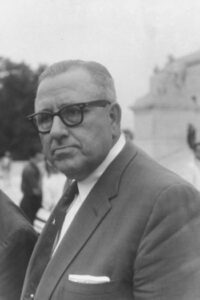
Virgil Blossom
*Virgil Blossom was born on this date in 1906. He was a white-American educator and administrator.
Born in Brookfield, Missouri, the son of George N. Blossom and Fannie M. Blossom, Virgil T. Blossom had one sister. His father ran a construction business and served as the local tax collector. His mother was a homemaker. Blossom attended public schools, excelling in athletics. He was also on the school’s forensics team. Blossom graduated from Brookfield High School in 1924 but went to Jefferson City, Missouri, where he became a clerk in the state legislature. In 1926, he was offered an athletic scholarship to Missouri Valley College.
An education major, he graduated in 1930. In 1930, Blossom worked as athletic director and social sciences teacher at Fayetteville High School in Washington County. He married Clarrene Tribble in 1934; they had two daughters. The Blossoms remained in Fayetteville until 1935, when Blossom accepted the athletic director job for Okmulgee High School in east-central Oklahoma. In 1938, he returned to Fayetteville as the high school principal. 1939, he completed an M.S. in education at the University of Arkansas (U.A.) in Fayetteville. In 1942, he became superintendent of Fayetteville’s public schools.
He implemented school improvements and expansion, annexing adjacent school districts that did not have high schools. He spent $2 million on a new high school and improvements on elementary schools and built a $200,000 athletic field and community recreation area. Also, as Fayetteville had no high school for black students, Blossom planned for them to attend segregated schools in Fort Smith. Blossom’s reputation as an educational leader resulted in his being hired as superintendent of public schools in Little Rock in February 1953. In May 1953, Fayetteville celebrated Virgil Blossom Day. Blossom continued his record of school reform in his new position, and he was honored as Greater Little Rock’s Man of the Year in 1955. However, the May 1954 U.S. Supreme Court decision in Brown v. Board of Education of Topeka, Kansas, against segregated schools displaced his agenda.
Given the strong segregationist sentiment among white southerners, Blossom believed the Court’s decision should have been “delayed until a later date.” Immediately, however, Blossom and the Little Rock school board began making plans to integrate Little Rock schools; he hoped the resulting plan, which became known as the “Blossom Plan,” would serve as a model for the desegregation of schools throughout the South. He met with various black and white groups to determine how best to comply with the ruling. Initially, he hoped to integrate elementary school students and progress each year until all grades were integrated. However, objections by white parents killed this plan; they especially feared that if black and white children became acquainted at an early age without learning “proper” social norms first, they would be more likely to become romantically involved as teenagers and adults.
Blossom suggested integrating at the high school level to assuage fears of miscegenation (intimate relationships between blacks and whites). At a meeting between the executive board of the Little Rock chapter of the National Association for the Advancement of Colored People (NAACP) and the city school board in September 1954, Blossom proposed the integration of four high schools, including Little Rock Central, Technical, Hall, and Horace Mann high schools. The original plan was to start the integration at the elementary schools, but as more elementary school parents spoke their opinions, the plan was to begin integration in the fall of 1957 at Central High School, then to the junior high by 1960, and the elementary level by 1963. The plan also included that any student whose race was a minority in their school could ask for a transfer. Despite the plan, General Faubus called the National Guard to turn students away from the school. On February 8, 1956, the Court made the Blossom plan a “court-mandated operation” carried out by President Eisenhower.
On September 24, 1957, the President integrated Little Rocks Central High School. Blossom received numerous death threats and promised to put him out of work during his term as the superintendent. Blossom wrote about his experiences in Little Rock, first as a series of articles in The Saturday Evening Post and in a memoir titled It Has Happened Here (1959). In July 1959, he became superintendent of the Northeast Independent School District in San Antonio, Texas. Blossom continued his record as an administrator. On January 15, 1965, he suffered a fatal heart attack.